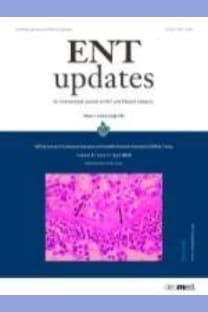Computed Tomographic Findings in the Nasal and Paranasal Sinuses of Patients Scheduled for Rhinoplasty at Mostafa Khomeini Hospital between 2011-13
___
1. Hammad MS, Gomaa MA. Role of some anatomical nasal abnormalities in rhinogenic headache. Egypt J Ear Nose Throat All Sci 2012;13:31-5.2. Hafezi F, Kouchakzadeh K, Naghibzadeh B. History and status of nose surgery. Iranian Journal of Surgery 2009;17:88-94.
3. Bradoo R. Anatomical Principles of Endoscopic Sinus Surgery: A Step by Step Approach. In: Pitman KT, editor. Book reviews. Head Neck 2007;29:302.
4. Muhammad IA, Rahman NU. Complications of the surgery for deviated nasal septum. J Coll Physicians Surg Pak 2003;13:565-8
5. Flint PW, Haughey BH, Lund VJ, et al. Cummings Otolaryngology Head and Neck Surgery. 6th ed. Philadelphia, PA: Mosby/Elsevier; 2015. p. 1565-9.
6. Haaga JR, Boll D. CT and MRI of the Whole Body. 6th ed. Philadelphia, PA: Mosby/Elsevier; 2017. p.1553-7.
7. Mendiratta V, Baisakhiya N, Singh D, Datta G, Mittal A, Mendiratta P. Sinonasal anatomical variants: CT and endoscopy study and its correlation with extent of disease. Indian J Otolaryngol Head Neck Surg 2016;68:352-8.
8. Andrades P, Cuevas P, Danilla S, et al. The accuracy of different methods for diagnosing seotal deviation in patients undergoing septorhinoplasty: A prospective study. J Plast Reconstr Aesthet Surg 2016;69:848-55.
9. Bolger WE, Parsons DS, Butzin CA. Paranasal sinus bony anatomic variations and mucosal abnormalities: CT analysis for endoscopic sinus surgery. Laryngoscope 1991;101:56-64.
10. Nikakhlagh S, Saki N, Tahmasbi M, Jouhari H. Anatomic variations of the bone in sinonasal CT scan: A report of 279 cases. Jundishapur Sci Med J 2008;6:476-82.
11. Talaiepour AR, Sazgar AA, Bagheri A. Anatomic variations of the paranasal sinuses on ct scan images. J Dentistr Tehran Univ Med Sci 2005;2:142-6.
12.SadrS,AhmadinejadM,SaediB,RazaghianF,RafieeM.Anatomical variations in sinus imaging in sinusitis: a case control study. B-ENT 2012;8:185-9.
13. Pérez-Piñas I, Sabaté J, Carmona A, Catalina-Herrera CJ, Jiménez-Castellanos J. Anatomical variations in the human paranasal sinus region studied by CT. J Anat 2000;197:221-7.
14. Sam A, Deshmukh P, Patil C, Jain S, Patil R. Nasal Septal Deviation and External Nasal Deformity: A Correlative Study of 100 Cases. Indian J Otolaryngol Head Neck Surg 2012;64:312-8.
15. Varshney H, Varshney J, Biswas S, Ghosh SK. Importance of CT scan of paranasalsinusesintheevaluationoftheanatomicalfindingsinpatients suffering from sinonasal polyposis. Indian J Otolaryngol Head Neck Surg 2016;68:167-72.
16. Abdi R, Majidi H, Kasiri AM, Barzin M, Madani SA. Evaluation of prevalence of the anatomical variation in paranasal sinuses in CT scan of the patients referred to Bina medical imaging center of Sari. J Mazand Univ Med Sci 2004;14:45-51.
17. Elsherif AAMH, Elsherif AMH. Some anatomic variations of the para nasal sinuses in patients with chronic sinusitis: A correlative CT study to age and sex. AAMJ 2006;4:1-15.
18. Riello APFL, Boasquevisque EM. Anatomical variants of the osteomeatalcomplex:Tomographicfindingsin200patients.RadiolBras 2008;41:149-54.
19. Lerdlum S, Vachiranubhap B. Prevalence of anatomic variation demonstrated on screening sinus computed tomography and clinical correlation. J Med Assoc Thai 2005;88:110-5.
20. Flint PW, Haughey BH, Lund VJ, et al. Cummings Otolaryngology Head and Neck Surgery. 6th ed. Philadelphia, PA: Mosby/Elsevier; 2015. p. 1570-5.
21. Huang BY, Lloyd KM, Delgaudio JM, Jablonowski E, Hudgins PA. Failedendoscopicsinussurgery:SpectrumofCTfindingsinthefrontal recess. Radiographics 2009;29:177-95.
22.NaderpourM,LotfiA,AyatE,EbrahimAA,BasiriF.Incidenceofanatomic variants in patients with chronic sinusitis. Med J Tabriz Univ Sci 2009;31:67-70.
23. Zinreich SJ. Imaging of chronic sinusitis in adults: X-ray, computed tomography, and magnetic resonance imaging. J Allergy Clin Immunol 1992;90:445-51.
24. Gupta AK, Gupta B, Gupta N, Tripathi N. Computerized tomography of paranasal sinuses: A roadmap to endoscopic surgery. Clin Rhinol Int J 2012;5:1-10.
25. Stammberger H. Endoscopic endonasal surgery-concepts in treatment of recurring rhinosinusitis. Part II. Surgical technique. Otolaryngol Head Neck Surg 1986;94:147-56.
26.KrzeskiA,TomaszewskaE,JakubczykI,Galewicz-ZielińskaA.Anatomic variations of the lateral nasal wall in the computed tomography scans of patients with chronic rhinosinusitis. Am J Rhinol 2001;15:3715.
27. Meyer TK, Kocak M, Smith MM, Smith TL. Coronal computed tomography analysis of frontal cells. Am J Rhinol 2003;17:163-8.
28. Han D, Zhang L, Ge W, Tao J, Xian J, Zhou B. Multiplanar computed tomographic analysis of the frontal recess region in Chinese subjects without frontal sinus disease symptoms. ORL J Otorhinolaryngol Relat Spec 2008;70:104-12.
- ISSN: 2149-7109
- Yayın Aralığı: 3
- Başlangıç: 2015
- Yayıncı: AVES
Çağatay Han ÜLKÜ, Demet AYDOĞDU, Abitter YUCEL, Fuat AYDEMİR
Börte Gürbüz ÖZGÜR, Erdoğan ÖZGÜR
Head and Neck Schwannomas: A Tertiary Referral Single-Centre Experience
Murat ÖZTÜRK, SEHER ŞİRİN, Fidan RAHİMLİ, FATİH MUTLU, Mete İŞERİ
Mustafa ÇOLAK, İsmet BAYRAMOĞLU, Hakan TUTAR, Şenay ALTINYAY
Balance disorders and hypothyroidism: A rare cause worth remembering
Ayhan KUL, ARZU BİLEN, Nuray BİLGE, Köksal SARIHAN, Hülya UZKESER, Ramazan DAYANAN, Fatih BAYGUTALP
Mehdi ABBASİ, Mohammad Ebrahim YARMOHAMMADİ, Poopak IZADİ
Successful partial cochlear implantation in a patient with relapsing polychondritisn
